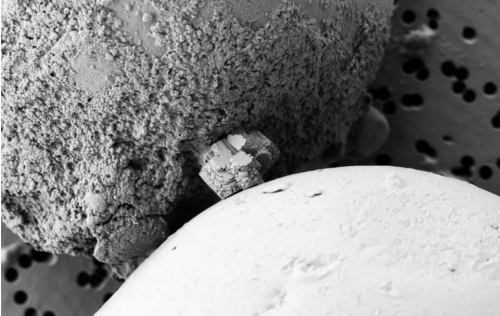本文转自《NBC News》发布的题为“Can we turn carbon dioxide to stone to fight climate change?”的报道。
作者:Lynne Peeples
原文链接:https://www.msn.com/en-us/news/msn/can-we-turn-carbon-dioxide-to-stone-to-fight-climate-change/ar-BBMxLs2

© Provided by NBCU News Group, a division of NBCUniversal Media LLC Image:In this photo, taken with a scanning electron microscope, tiny crystals of magnesite are forming.
©NBCU新闻集团,NBCUniversal Media LLC的一个部门提供图片:在这张照片中,用扫描电子显微镜拍摄,形成了微小的菱镁晶体。
As more heat-trapping carbon dioxide continues to concentrate in our atmosphere — and to wreak havoc on our climate — scientists are desperately seeking solutions. Some are looking for ways to limit the greenhouse gas we spew from smokestacks, tailpipes and the like; others, whose efforts remain largely under the radar, are aiming to thin the layer of gas that already blankets our planet.
随着越来越多的热量吸收二氧化碳继续集中在我们的大气中 - 并且对我们的气候造成严重破坏 - 科学家们拼命寻求解决方案。 有些人正在寻找限制我们从烟囱,排气管等喷出的温室气体的方法; 其他人,他们的努力基本上仍未被发现,他们的目标是使已经覆盖地球的那层天然气层变薄。
One group of researchers in Canada, taking the latter approach, may have hit upon a novel yet ancient idea: harness and accelerate the carbon-absorbing power of rocks.
加拿大的一组研究人员采用后一种方法,他们可能发现了一种新颖而古老的想法:利用和加速岩石的碳吸收能力。
The oceans, soils and trees aren't the only tools nature employs to capture and store away carbon dioxide. Minerals soak up the gas, too. They just tend to do it over extremely long time frames — far too slow to keep up with the rate at which the world emits carbon dioxide, which is estimated to be about 40 billion tons a year.
海洋,土壤和树木并不是大自然用来捕获和储存二氧化碳的唯一工具。 矿物质也吸收了气体。 他们倾向于在极长的时间内完成这项工作 - 这太慢了,无法跟上排放二氧化碳的速度,估计二氧化碳每年排放约为400亿吨。
"We have to learn how to remove carbon dioxide from the atmosphere, because we've already put too much into it," said Roger Aines, a senior scientist at Lawrence Livermore National Laboratory's energy program, who was not involved in the research. "Just making everything electric. Just making everything renewable. We have to do that, but that's not enough."
“我们必须学习如何从大气中去除二氧化碳,因为我们已经过多地排放了二氧化碳,”Lawrence Livermore国家实验室能源项目的资深科学家Roger Aines说,他没有参与这项研究。 “只需将所有东西都制成电器。只需将所有东西都改造下来。我们必须这样做,但这还不够。”
Climate models suggest that by 2050, the world will need to remove 10 billion tons of carbon dioxide annually from the atmosphere, or about 20 times the weight of all humans on Earth. So scientists have begun working on a myriad of carbon-sequestering strategies.
气候模型表明,到2050年,世界每年需要从大气中去除100亿吨二氧化碳,或者是地球上所有人类体重的20倍。 因此,科学家们已经开始研究无数的碳封存策略。
A team at the University of California, Berkeley, for example, is targeting reforestation and the restocking of carbon into soils. Engineers at Harvard University are testing machines that suck the greenhouse gas directly out of the air. Each strategy has merits, noted Aines, along with hefty price tags. "But if you can take a process that already wants to happen, and just encourage it to happen a little faster, you may be able to afford to do this," he said.
例如,加利福尼亚大学伯克利分校的一个团队正在瞄准重新造林和将碳补充到土壤中。 哈佛大学的工程师正在测试直接从空气中吸入温室气体的机器。 Aines指出,每种策略都有优点,而且价格不菲。 “但如果你能采取一个已经想要实现的过程,并且只是鼓励它发生得更快一点,那么你可能有能力做到这一点,”他说。
Throwing rocks at the problem, in other words, could make a significant dent.
换句话说,在问题上抛出先导研究可能会产生重大影响。
Just one cubic kilometer of rock laden with magnesite and other carbonate minerals — about the size of a medium-sized mountain — could lock down a billion tons of carbon dioxide.
只有一立方公里的岩石中含有菱镁矿和其他碳酸盐矿物 - 大约相当于一座中型山的大小 - 可以锁住十亿吨二氧化碳。

© Provided by NBCU News Group, a division of NBCUniversal Media LLC Image: The sun is seen through evening air pollution in BangkokIt's estimated that human activities are responsible for emitting about 40 billion tons of carbon dioxide a year.
©NBCU新闻集团,NBCUniversal Media LLC的一个部门提供图片:太阳是通过曼谷的夜间空气污染看到的。据估计,人类活动每年排放约400亿吨二氧化碳。
The Canadian team has devised a recipe to speed up the formation of magnesite, or magnesium carbonate, from hundreds or thousands of years in nature down to just 72 days in the lab. The key ingredient: tiny polystyrene microspheres — essentially latex beads — coated with charged molecules that help magnesium ions bond with carbonate ions to create magnesite.
加拿大团队已经设计出一种配方,可以加速菱镁矿或碳酸镁的形成,从实验中的数百年或数千年到实验室的72天。 关键成分:微小的聚苯乙烯微球 - 基本上是乳胶珠 - 涂有带电分子,帮助镁离子与碳酸根离子结合形成菱镁矿。
Compared to other carbonate minerals common near the Earth's surface, magnesite is particularly reluctant to form, and is therefore an apt target for the chemical cajoling. And once formed, the mineral is very stable. One ton of magnesite securely holds about a half ton of the gas.
与地球表面附近常见的其他碳酸盐矿物相比,菱镁矿特别难以形成,因此是化学实验想要的合适目标。 一旦形成,矿物质就非常稳定。 一吨菱镁矿可以牢固地容纳大约半吨的气体。
"It's a great way of storing carbon dioxide for a long period of time," said Ian Power, an environmental geochemist at Trent University in Canada, who presented his team's research at the Geochemical Society's Goldschmidt Conference in Boston on Aug. 14.
“这是长期储存二氧化碳的好方法,”加拿大特伦特大学的环境地球化学家 Ian Power说,他于8月14日在波士顿地球化学学会的Goldschmidt会议上展示了他的团队的研究成果。
What's more, the beads catalyzed the creation of magnesite at room temperature in the lab — and they stayed intact, ready to be used again. (Higher temperatures are known to speed up the production of magnesite. But added heat means added cost and energy, yielding the likely counterproductive release of carbon dioxide.)
更重要的是,这些珠子在室温下催化了菱镁矿在实验室中的产生 - 它们保持完整,准备再次使用。 (已知更高的温度可以加速菱镁矿的生产。但是加热会增加成本和能量,从而产生可能适得其反的二氧化碳释放。)
"The opportunity to do it is definitely worth investigating," said Aines. "And it's going to work. The question is how well and how fast."
“这样做的机会绝对值得研究,”Aines说。 “它会发挥作用。问题是如何以及如何快速。”
Greg Rau, a researcher in the Institute of Marine Sciences at the University of California, Santa Cruz, was more cautious about the magnesite research. While the results are "revealing," Rau said, "it is less obvious how this is a real breakthrough for carbon storage." The jury is out, he suggested, until further details come in regarding how the technique might be applied beyond the lab.
加州大学圣克鲁兹分校海洋科学研究所研究员Greg Rau对菱镁矿的研究更为谨慎。 虽然结果“揭示了”,但Rau说,“这对碳储存来说真正的突破是不太明显的。” 他建议,在进一步的细节到来之前,我们还不能确定这项技术在实验室之外的应用。
Possibilities, according to Power and Aines, include using the beads to increase the speed and decrease the cost of making magnesite in an industrial reactor. The beads may also speed up the underground formation of carbonate minerals, especially if combined with emerging technologies such as an injection method piloted by the CarbFix project in Iceland. While also speculative at this point, Power and Aines noted the potential for resulting rock to be put to use, perhaps as building material or in roads, which would increase the strategy's viability.
根据Power和Aines的说法,有可能使用这些珠子来提高速度并降低在工业反应堆中制造菱镁矿的成本。 这些珠子还可以加速碳酸盐矿物的地下形成,特别是如果与新兴技术相结合,例如冰岛CarbFix项目试点的注入方法。 虽然此时也是投机性的,但Power和Aines指出了可能将这块岩石投入使用的可能性,可能作为建筑材料或道路,这将增加战略的可行性。
"The big challenge is to do this economically and to have the political will," said Power, emphasizing the importance of putting a price on carbon to drive innovation and large-scale implementation of carbon capture and storage ideas. "I'm a strong believer that we need to have many, many solutions to really tackle climate change. I don't think there will be one silver bullet solution."
“最大的挑战是经济上和政治上实现这一目标,”Power表示,强调为碳排放价格以推动创新和大规模实施碳捕获和储存创意的重要性。 “我坚信,我们需要有很多解决方案才能真正应对气候变化。我认为不会有一个灵丹妙药。”
"This is like a major war," added Aines. "There's going to be an enormous amount of damage along the way. But we're going to win."
“这就像一场大战,”Aines补充道。 “沿途会有一些巨大的伤害。但我们会赢。”